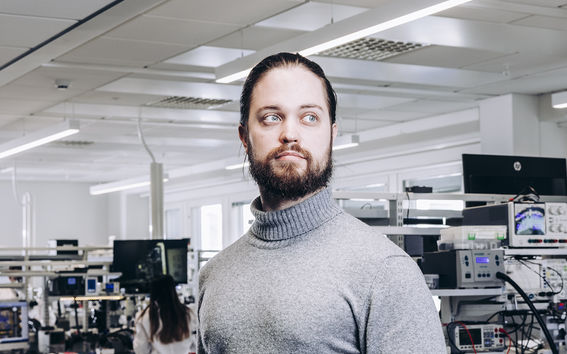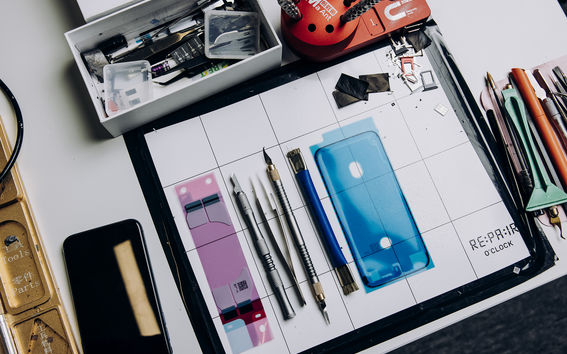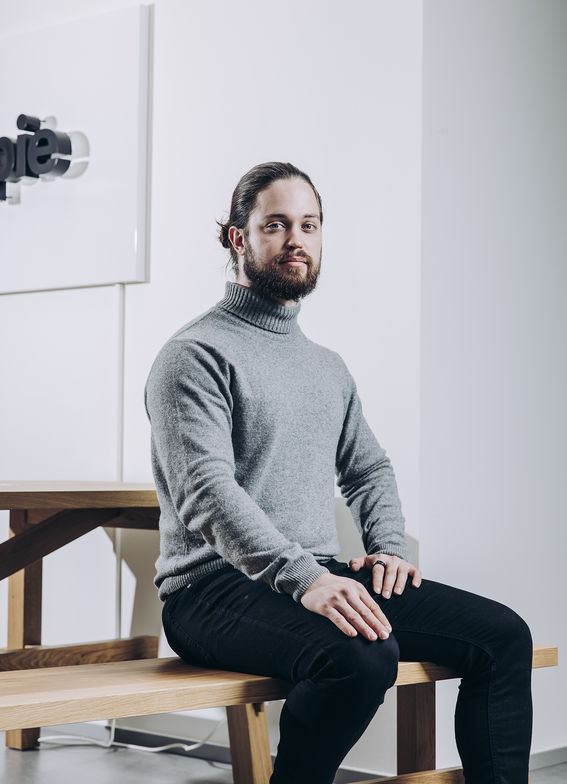Conquering the world with refurbished phones

In 2016, Aalto University student and entrepreneur Sami Marttinen wanted to buy a used smartphone through an online marketplace. The seller was sort of familiar: Marttinen shared a few Facebook friends with them. The seller seemed trustworthy and even sent photos of the phone in their hands.
‘After we agreed on a deal, they asked if I could pay upfront, so they could buy a new one the same day and avoid being phoneless. I sent the money, but my device never arrived,’ Marttinen recalls.
He later found out that this seller was behind many similar cons. Smartphone purchases involve bad experiences for lots of other people, too. Dodgy online sellers can advertise not only non-existent phones, but stolen or damaged devices as well.
For Marttinen, getting conned was no more than a passing annoyance, and the unfortunate event swiftly gave rise to an idea between him and study pal and business partner Jiri Heinonen.
Replacing smartphones every couple of years is a waste of resources and a major environmental problem. Lots of people would be happy to buy a used device for a lower price, were it not for a lack of trust. Marttinen and Heinonen decided to crack the unsolved problem of phone reuse in a big way.
‘From the very beginning, we were thinking about establishing a sensible alternative to buying new phones and making refurbished electronics mainstream globally.’
From tiny store to a firm of 500
When getting off the ground some four years ago, Marttinen would sometimes deliver phones to customers by bike. And when the shop needed a partition wall, he built one himself after checking out some online tutorials.
Swappie’s transformation has been rapid. In just a few years, the two-man boutique has grown into an international technology company with over 500 employees from 49 countries that generated €98 million in sales in 2020.
The firm’s mission is to make refurbished electronics a mainstream choice. Swappie specialises in refurbishing and selling iPhones; it evaluates the condition of used handsets before compensating sellers and then refurbishes them at its facility in Helsinki.
Coronavirus measures have impacted the availability of spare parts, but Swappie managed to successfully adjust and has continued its expansion to six new countries in Europe in 2020. The firm is focusing on European growth for now, but global expansion is by no means ruled out in the future.
‘Our biggest rivals are sellers of new phones. Similar smaller local actors do exist, but they typically do not invest in building the technology to make the phones stronger,’ Marttinen says.
Expansion involves the opening of an online store in the local language and adapting it to local consumer behaviour. The company’s only brick and mortar stores are in Helsinki’s Ruoholahti and the Iso Omena mall in Espoo.
Entrepreneurial since a young age
Sami Marttinen has known he’d one day start a business since he was a boy. At 15, he was already working with his dad in a construction business he helped establish, from filing the initial paperwork to labouring at the first site. He was officially just an employee, however.
Since his teenage years, he has thought about ways to make the world a better place. He eventually came to the conclusion that the best way to wield influence is through entrepreneurship. He wasn’t yet very aware of environmental issues, however.
‘An awareness of the state of the planet and climate change emerged at university.’
Solving major consumer problems has always fascinated Marttinen. He also wanted to find someone with a similar passion for getting things done and solving international problems.
The School of Business equipped Marttinen with business knowledge as well as entrepreneurial and tech skills. Among other things, he recalls the lectures of Esa Saarinen and Vesa Puttonen as well as Ville Hallavo’s inspiring way of teaching industrial engineering and management as especially helpful.
He found the opportunity to network and make contacts particularly beneficial. Marttinen was active in student life, engaged in lots of volunteer activities and took part in numerous events. He met his future business partner Jiri Heinonen at Aalto.
‘We share an interest in entrepreneurship, and talking about it in our free time led to our friends linking us together,’ Marttinen says.
They immediately hit the right note. Their first idea was to deliver healthy and convenient snacks to offices and homes.
Then the pair met with angel investor Ville Vesterinen at a startup event; he now chairs Swappie’s board.
‘We weren’t actually looking for funding, but happened to get talking with the right person, and one thing led to another.’
After a few weeks, they’d raised enough initial capital to test their first ideas. This is how Viking Shave Club, an online seller of razor blade subscriptions that later expanded to 21 countries, was created.
Marttinen and Heinonen are both determined and active personalities. The very next day after Marttinen was stung buying a phone, the two were in the Kamppi mall conducting a survey related to their newest business idea.

You can fix almost anything
The majority of a phone’s emissions is created during its manufacture, especially in conjunction with the mining of minerals, making the refurbishing and recycling of devices a significant environmental act.
The general perception is that phones simply aren’t made to last long and that they are difficult to repair. But most faults can be fixed, Marttinen says.
‘Repairs have, in fact, become more difficult, but this is precisely why we have focused on building world-class repair technology. We can fix anything and would theoretically even have the capability to manufacture our own devices.’
Phone refurbishment was typically outsourced when Swappie was getting started. Standards varied: the quality of the work depended on who was handling the job. Marttinen and Heinonen decided that the only way to change the market was for their firm to set up its own factory and develop its’ refurbishment operations to enable strengthening phones even from their original condition, as quality was one of the biggest reasons why consumers did not purchase refurbished devices instead of new ones yet.
Even an old, worn phone will function like new if it is professionally refurbished. Worn out parts and the battery are typically replaced.
‘Every phone goes through a 52-point inspection, after which faults are fixed and the phone is inspected again. It is also cleaned, disinfected and packaged before being forwarded to sales.’
Trial and learn
Their journey has involved experimentation and, when necessary, plans have been altered. Initially, Swappie aimed to establish stores in Sweden, and Marttinen even moved to live there for a while. But expansion proved to be slower than expected, and Swappie decided to go in another direction.
Building trust has been especially important for a seller of refurbished phones, as this business has a poor reputation in many countries.
Swappie checks international databases to verify a phone hasn’t been marked as stolen in any part of the world and its refurbished phones come with a 12-month guarantee. Marttinen declines to reveal what percentage of phones returns for maintenance during the warranty period, but says it’s in the single figures.
The duo wanted to learn about building trust in maximally difficult conditions, which is why their international project continued in Italy immediately after Sweden, as market research indicated it would be the toughest nut to crack.
‘Italians don’t make many online purchases, they don’t trust webshops or strange payment methods, they have little faith even in their neighbours. Building trust is difficult there. We figured that, should we not be successful in Italy, we’d at least learn much quicker there than elsewhere,’ Marttinen recalls.
Italy has since become Swappie’s biggest market area.
Marttinen thinks having the courage to experiment and take calculated risks, learning from both successes and failures, is important.
‘We prefer to think about ways with which to make something possible instead of thinking about what’s possible now.’
Text: Terhi Hautamäki
Photos: Aleksi Poutanen
This article is published in the Aalto University Magazine issue 28, May 2021 (facsimile copy on issuu.com).

Sami Marttinen
- Co-founded used iPhone seller and refurbisher Swappie together with Jiri Heinonen, now serves as CEO.
- He and Heinonen also founded snack firm Purtava and online razor blade service Viking Shave Club.
- Majored in marketing at the Aalto University School of Business.
Is also
- An ice swimmer. ‘I like to start my mornings with a swim or a gym session, and combining these with ice swimming during winter ensures high alertness throughout the day.’
- Enthusiastic about trying new things. ‘I tend to seek out my discomfort zone. When I went to the States as an exchange student, I got into four sports: American football, basketball, tennis and rugby – all of which I was very bad at to begin with.’
- A roof painter. ‘At 15, I joined my dad in the building industry with no prior experience. For the most part, we focused on painting and washing roofs.’
Sami MarttinenWe prefer to think about ways with which to make something possible instead of thinking about what’s possible now.
Read more news
Talent Boost Strategy Project at Aalto in 2021-2024
This article takes a look at the achievements of the Talent Boost project at Aalto.
Two new assistant professors started at the Department of Electronics and Nanotechnology
Two new assistant professors were appointed in the Department of Electronics and Nanotechnology at Aalto University's School of Electrical Engineering. Read the interview with Kim Kwantae and Paul Verrinder.
The Driving Renewal podcast delves into organizational renewal
What does renewal look like in different work environments? What does it mean in practice, and what does it demand from us as individuals?